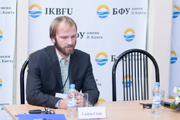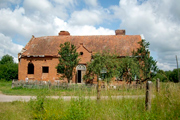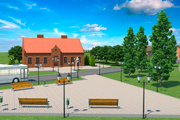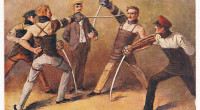Kant’s House: What is the Museum Going to be Like?
Kant’s House. Recently the historical object in Vesyolovka village and the museum complex being created as its part have been written about a lot. The conception of the museum’s creation and functioning is extensively discussed. IKBFU’s scientists take active part in the development of the museum’s conception and the formation of its collection. Vadim Chaly, Head of Philosophy Department at IKBFU, told us about the progress in recreating the valuable historical object and the works that are still left to be done in the near future.
Vadim, let us start from the beginning. What Kant’s House are we talking about and why has it come up quite recently?
We are talking about the old pastor’s house in Vesyolovka village of Chernyakhovsk district that used to be called Judtschen. Approximately from 1728 to 1771 this house was resided by pastor Daniel Ernst Andresch, and according to different sources either from 1747 to 1750 or from 1748 to 1751 Kant lived in this very house. After graduating from the university his difficult financial situation forced Kant to seek employment as a resident tutor, and he found it near Koenigsberg in pastor Andresch’s house, where he tutored his three sons.
Kant had a lot of spare time, and in Judtschen he worked on his first independent writings and maintained correspondence. Therefore the pastor’s house is important to us both as the place where Kant used to live and as the place where he was formed as a thinker. As for its long oblivion… It’s a difficult question. Philosophers and local history specialists have always known about it, but it is not the scientists who manage financing and other relevant issues. The important thing is that the situation has changed: everyone has heard about the house and there are plans to reconstruct it.
Who made these plans? Is it going to be another boring and archaic museum? And what will it be filled with? There are even no walls left from Kant’s time.
Yes, you are right. In the XIX century the house was reconstructed, and apparently only the basement is left from the house built in the XVIII century. But today the house has almost the same shape as in Kant’s time. So the walls are not the problem, after all we are talking about the philosopher who was concerned with non-material things. However, the museum’s conception is a serious issue. What should it be filled with? How can we make it interesting for wide audience and in the meantime maintain the connection with Kant’s name? This issue is actively discussed in the region’s administration that manages the reconstruction, and the university is involved in the discussion.
Today there are two conceptions. One of them was suggested by architect firm Serdtse Goroda and includes not only reconstructing the house, but also constructing two additional buildings to host a creative residence and a conference space, as well as creating a site for summer youth camps.
The creators of this massive project believe that additional functions will boost the attractiveness of this place for tourists, among others. No doubt, it is an important task. However, it is doubtful that such great sweep is reasonable. First, the provisioning and maintenance of such complex will require significant effort. Obviously it will require extensive financing as well, but the finance is outside philosophical competence, so I will not try to evaluate it. The university will hardly be able to take charge of any regular scientific events, summer schools, etc., in Vesyolovka. After all, we do have convenient facilities for them. Second, the single image of young teacher Kant is obviously not enough to fill such a massive project with meaning and content. Out of Kant’s eighty years of life he lived in Koenigsberg for seventy five. It is where his major works were written, and it would be a violation of scale to move the highlight to Judtschen-Vesyolovka by building a whole Kant-devoted complex there and leave out the good but relatively modest Kant museum in the Cathedral. Finally, if we address the matter of how Kant’s memory was memorialized in the German Judtschen, we will find almost nothing. In 1938 the village was renamed to Kanthausen, but it was done within a disputable campaign for getting rid of German toponyms, and there was no specific goal to highlight Kant’s presence. 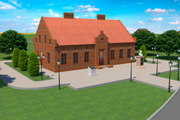 We can see in some pre-war pictures that in front of the entrance to the pastor’s house there was a monument to Judtschen’s citizens who died in World War I, but there was neither a monument of Kant, nor even a sign plate with his name on the house. But the house was there, and it was in a good condition. The task of bringing it to a good condition is the essence of the second conception that seems more appropriate to us and most of our colleagues-philosophers from Russia and foreign countries.
We can see in some pre-war pictures that in front of the entrance to the pastor’s house there was a monument to Judtschen’s citizens who died in World War I, but there was neither a monument of Kant, nor even a sign plate with his name on the house. But the house was there, and it was in a good condition. The task of bringing it to a good condition is the essence of the second conception that seems more appropriate to us and most of our colleagues-philosophers from Russia and foreign countries.
We think the project should include the reconstruction of the building and the creation of two exhibitions devoted to Kant and the great history of this region, a place for scientific and cultural events and a small park around the house.
Yes, this conception is more moderate, more academic and strict, if you will, but it appears closer to reality.
Did you succeed to defend this conception before the region’s government? Did they agree with the ideas of philosophers and historians?
Yes, our point of view was heard, but there are others. The desire to grasp the opportunity and use Kant’s name to set up a major project is perfectly understood. However, the project can take many different forms. For example, we can recall the village of Kurortnoye-Gross Wohnsdorf where in his middle years Kant used to visit the estate of his friends. In his old age, Kant was often reminiscing the time he spent there and these memories, according to the biographers, used to make him happy. In Kurortnoye there is still the tower of order castle where Kant used to sit on the porch and make philosophical conversations. German Kant scholars give even more attention to Kurortnoye than to Vesyolovka. It is likely for us to expect their bewildered questions if we undertake the incommensurable project in one place and completely ignore the other one. I admit there might be some questions from both our and foreign press, and the story concerning the Kant related places will attract not the most favorable attention.
The project, as the saying goes, is “image-building”, and it is essential to consider what it would look like from an outsider’s point of view, particularly in the eyes of tourists.
Is there any interest on the part of Germany? After all, Kant (speaking in present-day language) is a German brand, do German experts participate in discussion of the project of museum in Vesyolovka?
Kant’s ideas are a common heritage of humankind and there is interest to his figure not only on the part of Germany. However, it is mainly German colleagues who follow this project closely and help us collect the necessary information. For instance, Gerfried Horst, chair of “Kant’s and Königsberg’s Friends Society”, not only provided us with historical information but he also assisted with the arrival of Dr. Dierk Loyal, the descendant of immigrants from Judtschen, who studies the history of this region and possesses the extensive material which he kindly made available to all who have interest in that project. Experts from the Institute of Philosophy of Russian Academy of Sciences and from Russian State University for the Humanities are actively participating in the discussion and helping with materials. The reconstruction of the Pastor’s House was extensively discussed at the XI Kant Readings that took place in the university in April and gathered Kant scholars from many different countries. It may be said that the project is attracting international interest.
The last and the most important question: when will Kant’s House appear on the tour map and become a full-scale cultural center?
Hopefully, very soon. All decisions concerning this important for the region project are made by the region government, they require most thorough evaluation and endure no haste. The work is in progress, and we take part in its content-bearing aspects.


